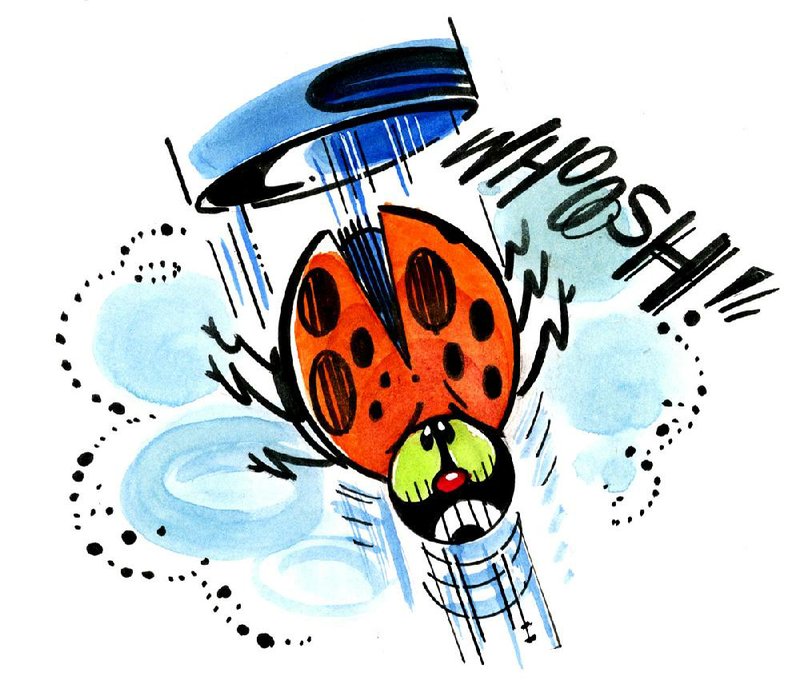Q For the third year in a row (we've lived here 30 years) as soon as it warms up a little we have a screened-in porch full (hundreds) of bugs. I thought they were ladybugs and so I would vacuum them up and put them outside. A friend said they were beetles and not ladybugs. They look like ladybugs to me, what are they? They get in the house too.
A It sounds to me like the Asian ladybug, which is a beetle, as are all ladybugs. The Asian ladybug adult is slightly larger than our native ladybug and can occur in several color patterns, from solid orange, orange with black spots, to red with black spots. It is a beneficial insect and feeds on pests such as aphids, mites, thrips and scale. Unfortunately, in the fall, they gather in large numbers on the outside of light-colored houses and can find their way inside through cracks or holes. They have also been known to get inside mailboxes, barns and garages looking for a place to spend the winter. They hibernate through the winter and become active again in spring. Vacuuming them up and putting them outside is a good idea. Do be aware that they emit a foul-smelling, yellow-staining substance when disturbed and that can stain whatever they touch indoors. Try to seal any cracks or openings to prevent them from coming in next fall.
Q This vine keeps growing under our privacy fence from the neighbors' fence and will root in our yard. Is it a clematis or what? How do I control it?
A The plant is variegated Vinca major. Although it is still sold in many garden centers as a groundcover for the shade, you and I know it is a noxious and invasive weed. My neighbor's backyard is solid in this, and it comes to visit me every year. Since we can't control what is in our neighbors' yards, all we can do is cut it back and spray with Round-Up on our side of the fence. I lay down sheets of cardboard and mulch at the fence line after I cut it back, and that helps for about a season, but then it starts coming back. Many folks do love the purple blooms and ease of growth, but it is too vigorous for my tastes.
Q My husband has pruned my white wisteria so that there will be very few blooms. Please help me to help him to know why, when and how to prune it correctly so I will have my beautiful white wisteria bush back.
A Wisteria is a spring-blooming vine that has its flower buds set when it goes dormant in the fall. After bloom is when it should be pruned. Pruning before it leafs out cuts off all the flower buds that are set. Wisteria is a prolific vine that needs to be pruned hard annually. Many gardeners prune it a little, and then when it grows too much, they keep pruning throughout the summer, which can also limit blooming. Prune as soon after bloom as possible and no later than June 15.
Q This was your response this fall: "Night blooming jasmine is not a true jasmine but Cestrum nocturnum. While it is hardy in south Arkansas, I have lost mine in central Arkansas by leaving it outdoors. That being said, the yellow and orange flowering cestrums are overwintering in the ground in Fayetteville at the Botanical Gardens of the Ozarks! I would try two things. Take some cuttings to root indoors to ensure you have a plant next growing season. For the one that is planted, as soon as we have a freeze, add extra mulch. It will also depend on the type of winter we have. Even if the top gets nipped back, it may re-sprout from the root system, so see what happens. Mine is in a container, so I plan to put it behind my shrubs -- between the shrubs and the house -- to see if that will protect it. It smells heavenly right now." Now, to give you an update: the night jasmine I asked about overwintering at the end of last summer did not make it. But I am very glad I took your advice. I have four good starters to plant in planters. Any advice on how to get them to flower this summer?
A I didn't get mine moved as I said I would, and it is a dead soldier now too. Glad you have new starts. Night blooming jasmine is a fast grower. I would get a large pot, and in a few weeks I would plant them in one large container in full sun. Water and fertilize, and you should have a blooming plant by mid to late summer.
Janet B. Carson is a horticulture specialist for the University of Arkansas Cooperative Extension Service. Write to her at 2301 S. University Ave., Little Rock, Ark. 72204 or email her at
HomeStyle on 03/18/2017

